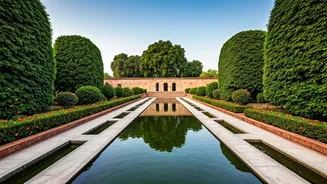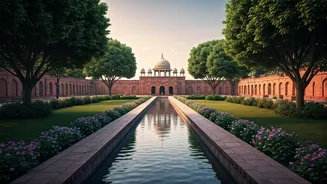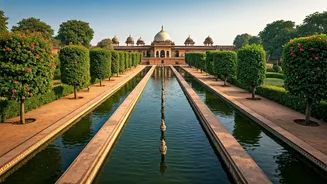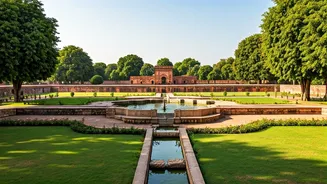Garden's Historical Echoes
Mughal Gardens in India showcase a rich blend of Persian, Central Asian, and Indian architectural styles, representing a period of significant artistic
and cultural exchange. These gardens, established during the Mughal Empire, are inspired by the paradise gardens (Charbagh) concept, featuring symmetrical layouts, flowing water, and lush greenery. The emperors commissioned these gardens not only for pleasure but also as symbols of power and artistry. Each garden holds stories of the Mughal rulers, the artisans, and the social context that shaped these splendid spaces. Their design reflects a harmonious relationship with nature, incorporating fountains, pools, and carefully curated vegetation to create a tranquil atmosphere. The historical significance lies not just in their beauty but also in their influence on garden design and landscape architecture throughout India.
Shalimar Bagh, Srinagar
Shalimar Bagh, situated in Srinagar, Jammu and Kashmir, stands as one of the most stunning Mughal Gardens. Built by Emperor Jahangir for his wife Nur Jahan in 1619, it's a prime example of Charbagh design. The garden, spread over four terraces, has intricate water channels, fountains, and beautiful pavilions. The terraced layout gradually ascends, providing a striking view of the Dal Lake. During its heyday, Shalimar Bagh served as the royal pleasure garden, where the emperors and their entourage spent their leisure time. The garden’s design prioritizes symmetry, water features, and an abundance of flowers and trees, reflecting Mughal taste for beauty. The garden’s enduring appeal lies in its picturesque setting and its association with love and royal history.
Nishat Bagh, Srinagar
Nishat Bagh, also in Srinagar, is another jewel in the crown of Mughal Gardens. Constructed by Asaf Khan, Nur Jahan’s brother, in 1633, the garden translates to “Garden of Delight”. Nishat Bagh follows a unique layout with twelve terraces, each representing a sign of the zodiac. The garden descends towards the Dal Lake, offering stunning views and enhancing its appeal. The design of Nishat Bagh focuses on providing a visual and sensory experience. The flowing water channels, meticulously arranged flowerbeds, and verdant trees create a captivating environment. The architecture and landscape of Nishat Bagh highlight Mughal artistry, providing a perfect blend of natural beauty and human design. Visiting Nishat Bagh offers insight into the imperial pleasure and the aesthetic sensibilities of the Mughal era.
Vrindavan Garden, Mysore
Vrindavan Gardens, located in Mysore, Karnataka, is a notable Mughal-style garden, especially celebrated for its musical fountain. Developed by the Krishnaraja Wadiyar IV, it was completed in 1932. Though inspired by Mughal design, it reflects regional aesthetics. The gardens, spread across terraces and designed around the Krishnaraja Sagar Dam, are a popular attraction. The musical fountain is a key feature, synchronized to music and lighting, which draws huge crowds. The gardens are known for their symmetry, geometric patterns, and use of vibrant flowers and plants. Vrindavan Gardens offer a modern interpretation of the Mughal design, attracting tourists and locals alike with its entertainment and scenic beauty.
Pinjore Garden, Haryana
Pinjore Garden, also known as Yadavindra Garden, is located in the Panchkula district of Haryana. Constructed by Fidai Khan, a Mughal architect, in the 17th century, it is known for its beautiful layout and historical value. The garden follows the Charbagh pattern, with seven terraces. Each level features unique design elements, including pavilions, fountains, and water channels. The design integrates nature and architecture. Pinjore Garden provided a place for recreation for Mughal officials. The garden remains a great example of Mughal landscape architecture, combining Persian and Indian styles. Today, it’s a popular spot for picnics and cultural events, offering visitors a glimpse into the elegance of Mughal gardens.
Humayun's Tomb Garden
The garden surrounding Humayun's Tomb in Delhi is a fine example of the Mughal Charbagh design. Built in the 16th century, the tomb and its gardens show the initial stages of Mughal garden architecture. The garden is split into four main sections, with water channels, pathways, and green spaces designed around the tomb. The garden represents the vision of paradise, reflecting the Mughal taste for order, symmetry, and beauty. The design includes fountains, reflecting pools, and a variety of plants, creating a balanced and peaceful setting. This garden is important to the evolution of Mughal gardens in India, influencing the design of subsequent projects.
Mehtab Bagh, Agra
Mehtab Bagh in Agra, located across the Yamuna River from the Taj Mahal, is a restored garden with a historical link to the iconic monument. This garden, developed during the Mughal era, likely served as a viewing spot for the Taj Mahal. The landscape is designed around geometric patterns and offers picturesque views of the Taj Mahal. The planting of various flowers and plants adds to the garden's visual appeal. The careful design of Mehtab Bagh provides visitors with a unique perspective on the Taj Mahal. It is a peaceful place to reflect on the beauty and legacy of Mughal architecture.
Taj Mahal Garden
The Taj Mahal Garden, an integral part of this world-famous monument, is a perfect illustration of Mughal garden design. The garden is meticulously laid out in a Charbagh format, divided into four quadrants by water channels. These channels reflect the image of the Taj Mahal, creating symmetry and serenity. The use of fountains, pathways, and diverse flora enhances the aesthetic experience. The garden symbolizes the Mughal ideal of paradise, reflecting concepts of beauty, balance, and harmony. The Taj Mahal Garden emphasizes the Mughal architectural and landscape design, making it a major landmark of Indian culture and history.
Rambagh Garden, Agra
Rambagh Garden, also situated in Agra, is among the oldest Mughal Gardens. The garden was built by Babur, the first Mughal emperor, as his resting place. Its layout displays an early interpretation of the Charbagh design, featuring symmetrical layouts and water features. The garden has undergone several transformations over the centuries but continues to reflect its historical origins. The environment showcases the Mughal preference for symmetry, water elements, and lush greenery. Rambagh Garden serves as a window into the Mughal era, providing a peaceful escape for visitors.
Lodhi Garden, Delhi
Lodhi Garden, in Delhi, merges Mughal garden elements with architectural influences from the Lodhi period. The garden features tombs, mosques, and other structures from the Lodhi and Sayyid dynasties. Though not entirely in the Mughal Charbagh style, it incorporates key features. The garden is a green space within the city, with beautiful views. Lodhi Garden demonstrates the integration of different architectural styles. It's a place for history, leisure, and a representation of Delhi’s cultural heritage.














